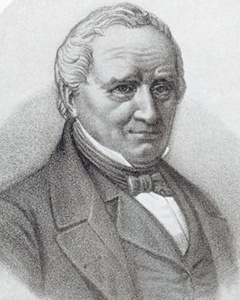
Augustus Graham
Biography
Augustus Graham and his camerado John Bell Graham were founding fathers of Unitarianism in Brooklyn, as well as the founders of many critical arts and social welfare organizations, in the generation just before Walt Whitman’s.
According to Olive Hoogenboom, Augustus Graham and John Graham employed hundreds of Brooklyn’s unemployed; addressed the city’s chronic alcoholism; helped establish a spiritual alternative to fundamentalism; cared for the city’s sick, indigent, and widowed via the Brooklyn Hospital and several retirement homes; and gave Brooklynites unprecedented access to books--thereby laying the foundation for an institution that soon evolved into the Brooklyn Museum, the Brooklyn Children's Museum, and the Brooklyn Botanic Garden. Hoogenboom is one of the few scholars to have ever closely studied the legend of Brooklyn’s “Brothers Graham.”
Their warm acceptance in Brooklyn society during the 1830s is significant, but there was clearly a dark side to it. In the first place, Augustus and John were forced to pretend to the world at large to be brothers. And after their live-in companion Isabella Graham Taylor died, they installed a beautiful bust of her at the gravesite. It disappeared, for reasons not explained in the history. Augustus decreed that his own gravesite bust would not display any name. During the years after his granddaughter made a superb copy of the famous Francis Guy painting of Brooklyn village, the part of the canvas that showed his house on Front Street was damaged by fire.
Augustus Graham became one of early Brooklyn’s most important civic leaders--a key businessman and philanthropist. He was born Richard King in Devonshire, England, but for reasons unknown, when he immigrated to Maryland, he began to use the name Augustus Graham. Around the time of his marriage to Martha Cocks, he met John Bell, a Scottish immigrant, and they partnered to operate a stagecoach line from Frederick to Baltimore. The standard book on Brooklyn history by Henry Stiles says that the two decided to "unite their capital, adopt a kindred name and relation, and proceed further north in quest of better fortunes." The two self-styled “brothers” moved to New York state, and eventually to Brooklyn. Stiles wrote, “This simple and romantic scheme [ultimately led to] the happiest result… Their union was always of the most affectionate and confidential character.” (After many decades, they drifted apart, maintaining separate households, while still remaining friends. For instance, in their declining years, they continued to share a carriage, but each man hitched his own horses to it.)
In 1822, the Brothers Graham cashed out a brewery operation, and then Augustus Graham established a factory for tuning lead into white pigment. This pigment business became more successful than anyone would have imagined. Two years later, Augustus established the Apprentices' Library, which offered his young workers educational alternatives to gambling and drunken revelries in the taverns. The couple, who had made their first small fortune from beer or whiskey, now actively supported the temperance cause. Stiles takes great pains, in his history, to point out that “Mr. Graham directed that neither the lecture room nor any other part of the building should be used for any political purpose, or any exhibition, or any lecture on any subject having an immoral tendency.” [2:894] Later, Augustus helped found the First Unitarian Church of Brooklyn. Stiles explains that he was deeply motivated by a concern for the "neglected portions of the community." The Unitarian church in those days was often being strongly rebuked by fundamentalists for its liberal theology.
When he died in 1851, Augustus left an estate of $300,000, including $20,000 earmarked to support the growth of Unitarianism. Stiles says, “He evidently felt that he was but the steward of God” and stresses that his public acts of charity were far exceeded by private acts. Stiles claimed that the results of those acts of kindness “will probably never be revealed on this side of eternity.” [2:894] Likewise, John’s 1853 obituary in the Brooklyn Daily Eagle says. “He had a kind heart and an open hand. He was a very plain man... and without what is generally regarded as great intellect, but he has done more for this race than thousands who are far more liberally endowed.” [BDE March 11 1853] In another place, Stiles sums up: “Brooklyn will ever have reason to cherish the memory of the twain, recognized among us, for nearly half a century, as the Brothers Graham.” [2:838]
References:
“Augustus Graham.“ Hoogenboom, Olive. http://www.uua.org/uuhs/duub/articles/augustusgraham.html
Stiles, Henry. “A History of Brooklyn, Vol 2” http://www.panix.com/%7Ecassidy/stilesv2/v2c1/contents1.html
Brooklyn Daily Eagle Online. www.brooklynpubliclibrary.org/eagle/
Biographical statement written by Mitchell Santine Gould, curator, www.LeavesofGrass.org
Biography Date: February, 2004
Tags
Unitarian Universalist | New York | New York City
Citation
“Augustus Graham | Profile”, LGBTQ Religious Archives Network, accessed April 19, 2024, https://lgbtqreligiousarchives.org/profiles/augustus-graham.
Remembrances